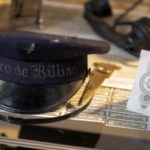BBVA's Historical Archive: memory, so as not to forget
“We are our memory, we are that chimerical museum of shifting shapes, that pile of broken mirrors.”
― Jorge Luis Borges, in Praise of Darkness

Three mini-documentaries focus on one of the places that safeguard the memory of BBVA: its Historical Archive. This project, begun in the 1970s, holds more than 160 years of the bank's history and as such, provides a glimpse into the past of Spanish society.
Part I - After the Origins of BBVA Historical Archives
Bilbao grew up on the banks of a river and its history is intrinsically tied to water. The city emerged at the point where the river begins to be navigable. Industry and commerce determined Bilbao's economic growth and the river helped to move that growth forward.
The economic boom and the need to finance new projects led the merchants and industrialists of Bilbao to go into the banking business, in order to guarantee the region's vigor. Apart from industry, Bilbao had all the characteristics needed to generate wealth. It also had access to the sea, thanks to the river, which strengthened foreign trade and international expansion.
Part II - Buildings that marked the beginnings of BBVA
The first space occupied by the Banco de Bilbao was a desk in an office on old Estufa Street. But within a few months, that office was too small for the bank's overflowing activity. The construction of the San Nicolás palace, the merger with the Banco del Comercio and later, with the Banco de Vizcaya, created an interesting architectural triangle: on one side of the river was the San Nicolás palace and on the other, numbers 1 and 12 of Gran Vía, one of the main streets of Bilbao.
The expansion of the bank took place through a series of mergers that gave rise to BBVA. The bank's DNA was completed on October 19, 1999. Argentaria ―an historic banking institution comprised of such important banks as Banco Hipotecario de España, Banco Exterior de España, Caja Postal de Ahorros, Banco de Crédito Local, Banco de Crédito Agrícola and Banco de Crédito Industrial― joined forces with BBV. With this merger, the formation of the present-day BBVA was largely completed.
The institution's very history –covering more than 160 years– explains a large part of the history of Spanish society. That historical perspective led the bank in the 1970s to create its Historical Archive.
Part III - A tour through BBVA's Historical Archive
BBVA's documentary collection is the first of any bank in Spain. The Historical Archive is nourished by documents from more than 150 banks that eventually were merged, and it contains a total of 14 kilometers of documents. There is also a multitude of objects from different eras: bank notes, typewriters, computers, credit cards, documentation on projects requiring financing, safes… objects from daily life that explain history.
The work of the Historical Archive is carried out with the help of researchers and through the organization of exhibitions that have an informative purpose. The heritage of BBVA transcends its long history; a walk through the corridors of the Historical Archive is a way of traveling in time and discovering what society was like back then.